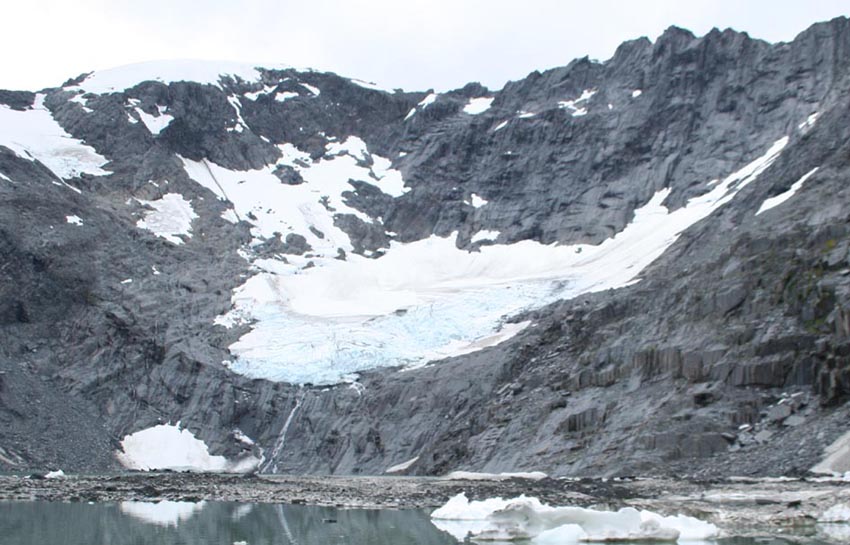Glaciers are dynamic bodies
of ice: snow accumulates in the upper regions and turns into ice
under the effect of freeze-thaw cycles and high pressure; ice flows
down valley under the force of gravity and eventually melts at the
lower altitudes. In times of below-average temperatures or
above-average precipitation, the accumulation of ice at the top
exceeds the volume that melts at the bottom, and the front of the
glacier advances, like a swollen river of ice. In warmer or drier
periods, when the melting action exceeds the formation of ice, the
glacier shrinks.
Since the end of the little
ice-age in the late 1800s, most glaciers worldwide have been in a
phase of active retreat, which seems to have accelerated in the
last decade under the effect of human induced global warming.
During a phase of glacial recession, a glacier not only becomes
shorter (the front moves back up the hill), but it also becomes
thinner, as the layer of ice loses mass on its whole
length.
As a result of glacial
recession, a glacier may eventually vanish altogether. But a number
of signs are left behind on the ground, and tell us about the
history of the site for a long time to come: moraine walls mark the
borders of the glacier’s maximum extent, scrape marks on polished
rock show where ice was once flowing, and a lake may often fill the
scoop carved by the glacier’s tongue behind the terminal moraine
wall.
Ivory
Lake
is a typical example
of a glacier-carved lake. The Ivory Glacier is still visible
perched high up on the mountain, a small remnant of the large
river of ice that once filled the whole basin.

The purpose of this
Earthcache is twofold:
A) You’ll get a chance to
see with your ice how fast a glacier can retreat, and the
impressive marks it leaves behind on the landscape.
B) You’ll be participating
in a “group project” documenting the retreat (and possibly the
disappearance) of a glacier, by posting photographs taken from the
same site over a number of years.
To log this cache, you must
fulfill the following requirements:
- In the nearby hut, you’ll
find a typed manuscript with a glaciology study dating back to the
1970s. Send an e-mail to the cache owner, with the title of the
study, and a summary of the main points you got out of the
manuscript (200 – 300 words). Do not post this information in your
log.
- Post a picture of the
Ivory Glacier; please try and frame it somewhat similar to the
above. The following conditions apply: the mountain must be clear
of cloud (the whole glacier must be visible), and it must not be
covered in snow. No point in logging the cache
if you visited the site in bad weather, or in winter, as you won’t
be able to fulfill its main requirement.
- Post a picture of some
scrape-marks left by the ice on the rocks.
- Post a picture of yourself
at GZ.
- In your log, describe
(briefly) the route you followed to get in and out of Ivory Lake,
with a couple of photographs taken along the way.
Please notice the
following:
* This is serious country,
and takes a lot of effort to get into. For most people, it will be
at least a week walking (entirely off track) to get in and out of
GZ. It is not the purpose of this listing to tell you how to get
there. If you are experience enough to complete the trip, then you
know where to find the relevant information
* This is remote
trampers country, where piece and
quiet reign supreme. The only way in and out is on foot. If
you cheat by making use of any sort of noisy and polluting
motorized means (e.g. helicopter), your log will be deleted
(hence the last of the above requirements).
Enjoy!